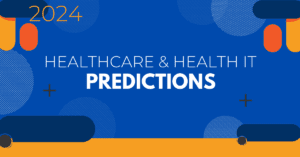As we kick off 2024, we wanted to start the new year with a series of 2024 Health IT predictions. We asked the Healthcare IT Today community to submit their predictions and we received a wide ranging set of responses that we grouped into a number of themes. In fact, we got so many that we had to narrow them down to just the best and most interesting. Check out our community’s predictions below and be sure to add your own thoughts and/or places you disagree with these predictions in the comments and on social media.
All of this year’s 2024 health IT predictions (updated as they’re shared):
- John and Colin’s 2024 Healthcare IT Predictions
- Health Equity Predictions
- Healthcare Cybersecurity Predictions
- Telehealth and VR Predictions
- Value Based Care Predictions
- Pharma IT and AI Predictions
- Healthcare Interoperability, Data, and Cloud Predictions
- Healthcare Workforce Predictions
- Healthcare Generative AI and Data
- Healthcare AI Regulations and Ethics
And now, check out our community’s Healthcare Generative AI and Data predictions.
Steve Kent, Chief Product Officer at Know Labs
2024 will be a seminal year for advancements in medical monitoring due to the power of artificial intelligence (AI) and as a subset, machine learning (ML). There are more medical devices and wearables than ever before, producing massive amounts of continuous, robust data. ML has unlocked the capability to streamline the management and analysis of large, complex datasets produced by these new technologies. This is key to informing the development of predictive and preventive solutions that support a patient’s understanding of what is going on inside their body – enabling them to better manage their own health.
However, in order to achieve this, the right data collection methods must be used to prioritize accurate and meaningful algorithm development. It is mandatory that devices built to improve health outcomes can do so accurately and safely across all intended populations and use cases. As these devices continue to advance in 2024, we can expect to see a heightened emphasis placed on capturing high-resolution, continuous data to mitigate bias and build equitable ML algorithms.
Cambron Carter, Co-Founder and Chief Technology Officer at Pearl
This year, more practitioners made use of AI to assist their daily diagnostic activities and to discover deeper trends within their patient populations. More patients have been exposed to AI than ever before, as well. 2023 has made clear that this technology will be an expected standard of care for the next generation of patients.
As we enter 2024, we can expect to see more focus on a common bottleneck in healthcare: interoperability. As AI advances and conversations around regulations and standardization take precedence, there will be a larger industry-wide emphasis on breaking down information silos and creating a more open and collaborative approach to data aimed to unleash AI’s full potential in clinical care, predictive diagnostics, and personalized treatment planning.
We can also expect to see an avalanche of large language model solutions. Luckily, healthcare has many problems which are well-suited for these solutions. In true application and scale, this technological paradigm may end up cutting its teeth in the healthcare sector.
Amy Brown, Founder and CEO at Authenticx
Humans spend their day communicating with each other, with those words exchanged in conversation — via text or recorded voice — falling into the category of unstructured data. This data will continue offering robust, contextual insights that can impact all functional areas of an organization. AI can help analyze unstructured data at scale, to understand what people talk about. Understanding leads to better decisions; better decisions lead to better outcomes for both business and customers. Smart companies will approach AI with a great deal of intentionality and responsibility, recognizing the opportunity is not just in replacing human effort, but also in understanding the impacts of listening.
Scott Hondros, MHA, SCPM, Vice President of Services Commercialization & Strategy at CenTrak
AI is poised to significantly enhance healthcare industry processes and facilities. AI and Machine Learning (ML) can produce predictive analytics, utilizing historical data for valuable insights and forecasts, aiding hospitals in resource optimization and patient care enhancement. A recent CenTrak survey revealed that 89% of our strategic customers are actively discussing AI integration, with 79% considering its implementation crucial shortly. The synergy between Real-Time Location Systems (RTLS), AI/ML, and hospital operations improvement is promising, especially for leveraging RTLS-gathered clinical and operational data for predictive analytics and actionable insights, aiding process optimization for efficiency and patient care in 2024.
In 2024, collecting actionable data will enable AI/ML to offer predictive analytics on patient-staff interactions, infection prevention, and equipment utilization. RTLS platforms can serve as centralized hubs for AI-driven actionable insights at every RTLS journey phase, forecasting events like staff duress occurrences, asset restocking needs, and staff allocation and scheduling optimizations. This could significantly aid healthcare executives in meeting key performance indicators (KPIs), supporting staff, calculating ROI, and surpassing industry benchmarks.
The healthcare sector must discover optimal ways to harness AI, complementing healthcare professionals to improve patient outcomes without diminishing the human element. The objective is not to supplant human roles but to harness AI’s additional value to aid staff, patients, and their families. Properly executed, AI and automation can cut down non-clinical workloads, freeing up professionals to focus on direct patient care. The industry’s aim for 2024 should be this collaborative approach and ensuring data safety as we advance this remarkable technology.
Healthcare organizations aim to strengthen communication channels. Integrating RTLS visibility with patient workflow software allows automated text updates for patient-approved contacts, enhancing trust, clarity, and safety. RTLS can also enable proactive patient communication, sharing updates, wait times, and navigation instructions, guiding our approach for 2024.
Brian Laberge, Solutions Engineer, Health Language at Wolters Kluwer Health
Readying health data for AI prime time. Health organizations are making it a strategic priority to extract more value from the volumes of data they’re moving to the cloud. One big health data target in 2024? Training AI models on all that data. To make it happen, however, they’ll first need to untangle a rat’s nest of messy data. In the race to build data-rich AI models in ’24, many will turn to AI-driven terminology tech that speeds the normalization of data, making it ready for prime time.
Steve Kearney, Global Medical Director at SAS
Generative AI in health care evolves to bolster patient care. To advance health and improve patient and member experiences, organizations will further develop generative AI-powered tools in 2024 for personalized medicine, such as the creation of patient-specific avatars for use in clinical trials and the generation of individualized treatment plans. Additionally, we will see the emergence of generative AI-based systems for clinical decision support, delivering real-time guidance to payers, providers, and pharmaceutical organizations.
Jeff Robbins, Founder and CEO at LiveData
The generative AI revolution will continue to attract the headlines. AI and machine learning technologies will continue to advance and be more deeply integrated into various healthcare sectors. From diagnostics and personalized treatment plans to administrative tasks like billing and scheduling, AI-driven tools will streamline processes and improve patient outcomes. This progress will be enhanced by more robust and accurate data collection tools in real-time rather than relying on the memories of overworked healthcare teams. Along with this accelerated progress will come heightened scrutiny about data governance, especially concerning protected health information; vendors will create offerings to protect sensitive data.
Punit Soni, Founder and CEO at Suki AI
Generative AI has been the hot topic of 2023. As the technology continues to make inroads specifically in healthcare, we can expect to see even more advancements towards the mass adoption of AI-powered tools and voice assistant technology.
As a technologist at heart, Punit shares some predictions that we can expect to see in 2024 below:
- Lots of consolidation in the offing in the healthcare tech industry. Small players will die or be bought
- LLMs will be a commodity. The industry will revert to who can provide the best full-stack product, privacy/data security, reliability, and customer satisfaction
- Health systems will double down on AI safety, privacy, and security as key factors in deploying AI
- Major tech players in healthcare will brace for regulation, which will create some significant burden for them
- AI tech in healthcare will move beyond clinical documentation to other use cases like patient summarization, coding, data retrieval, etc.
Natalia Arzeno-Gonzalez, Chief Data Scientist at Infinx Healthcare
Over the past year, we’ve witnessed a significant surge in generative AI research and innovation. 2024 promises to be a groundbreaking year in healthcare optimization, with gen AI redefining various facets of revenue cycle management.
I expect to see LLM applications emerge to help explain medical concepts, summarize lengthy clinical notes, categorize documents, or add structure to free-text data. Applications will partly depend on further advancements in LLMs, particularly in enhanced information extraction capabilities, to ensure accuracy and relevance in healthcare contexts.
Some applications will assist in ensuring claims meet medical necessity criteria and analyzing extensive payer guidelines and clinical notes for comprehensive compliance. The use of LLMs in automating prior authorization requests will become more refined, offering faster and more accurate processing.
The use of gen AI in medical coding will enhance accuracy and compliance, significantly improving the coding process by analyzing extensive medical records, as well as mitigating errors in data entry by analyzing a multitude of documents to pinpoint inaccuracies or omissions.
On the back end, claim management use cases could include improving the efficiency of claim management, reducing denials, and streamlining appeal processes through advanced text analysis.
The possibilities are vast, and it’s essential we consider them thoughtfully and evaluate them carefully to identify appropriate use cases, especially considering LLM response variability, hallucinations, protected health information (PHI), and security compliance.
Derek Streat, Co-Founder and CEO at DexCare
The emergence of AI took hold of our collective imagination. Today, millions use generative AI to create, understand, and build novel applications. The proliferation of AI will accelerate as we enter the New Year. And in healthcare, we can expect to see the fissures of disruption, as AI works to reduce administrative burdens, streamlines how consumers find and select care, and crowdsources massive datasets to achieve better diagnoses and treatments. Health systems are already deeply invested in AI, but the possibilities, cures, and operational intelligence are only beginning to reveal their potential.
Todd Gottula, Co-Founder and President at Clarify Health
The healthcare industry is poised for a revolutionary transformation in 2024, driven by the widespread adoption of generative AI. This technology goes beyond traditional data analysis, enabling the identification of intricate patterns in healthcare data while introducing a transformative conversational interface, like Clarify Health’s Clara. Historically, complex user interfaces have hindered healthcare professionals from effectively accessing and utilizing data insights. However, the emergence of conversational AI interfaces will dramatically simplify this process. Users can now easily ask questions in plain language, receive understandable insights, and make the technology more accessible. This transformation democratizes access to valuable information across various sectors and may be further accelerated by the implementation of reward structures based on conversational engagement. The convergence of generative AI and conversational interfaces is set to make vital insights integral to daily decision-making processes within the healthcare industry, heralding an era of unprecedented change.
Robert Connely, Global Market Leader for Healthcare at Pega
Generative AI will revolutionize healthcare by optimizing operational efficiency and patient engagement. The current system suffers from misalignment and coordination issues, leading to suboptimal outcomes. Administrative tasks cause worker burnout and can lead patients to abandon care. For instance, 89% of physicians believe that prior authorization delays can negatively impact clinical outcomes. Generative AI will streamline workflows, enabling healthcare teams to manage complex tasks, reduce administrative tasks, and improve patient communication. It will enhance patient literacy and engagement by providing personalized, easily understood health information, and fostering proactive patient interactions. Imagine automated outreach campaigns, like flu shot reminders, achieving high response rates and delivering unparalleled patient interactions. With AI, providers can dedicate more time to diagnosis and treatment.
David Lareau, CEO at Medicomp Systems
The proliferation of generative AI applications will lead to a need to provide validation of the output of large language models––particularly in the medical environment, where clinicians will require tools to verify the AI-generated information. There is already talk of requiring “guardrails” for AI-generated content, which will only increase as applications make increasing use of generative AI in clinical settings.
Stacey Caywood, CEO at Wolters Kluwer Health
Top 4 impact drivers for generative AI in 2024. 2024 will be a watershed year for generative AI, particularly in healthcare. Look for solutions emerging in four key areas in 2024: lightening administrative burdens across the hospital; helping sharpen clinicians’ decision-making; boosting the efficiency of medical researchers; and helping the next generation of healthcare workers ramp up proficiency with smarter learning tools.
Israel Krush, CEO and Co-Founder at Hyro
1. Generative AI will be harnessed to personalize patient communication with healthcare providers on a mass scale. Expect to see generative AI-powered web assistants that can safely and securely retain context when interacting with patients while being able to tap into their electronic medical records in a compliant, safety-first manner in order to proactively suggest relevant services and treatment options. This personalized communication will be not only reactive but also proactive, predicting the patient’s needs based on their medical history and preferences.
2. Many generative AI startups that emerged in late 2022- early 2023 will be forced to close shop or pivot, driven mainly by rapid technological and regulatory changes. People underestimate how difficult it is to prevent generative AI tools from spewing out false and/or harmful information, and while the gen-AI tech stack is rapidly evolving – keeping the chatbot’s responses in-tact, compliant, and accurate is going to be a big challenge for organizations, especially in regulated industries such as healthcare and financial services. It’s now easier than ever to produce an incredibly impressive demo but just as hard (potentially even harder) to build a trusted gen AI product/platform.
Be sure to check out all of Healthcare IT Today’s Healthcare Generative AI and Data content and all of our other 2024 healthcare IT predictions.
Get Fresh Healthcare & IT Stories Delivered Daily
Join thousands of your healthcare & HealthIT peers who subscribe to our daily newsletter.




